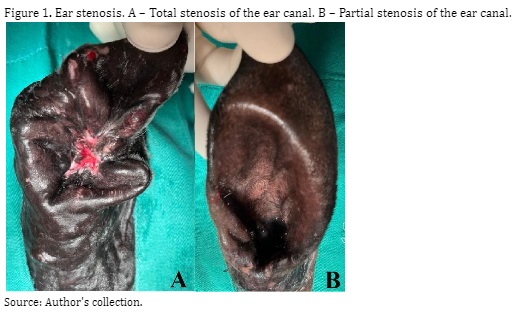Modified technique for lateral resection of the ear canal in six horses with auricular stenosis
DOI:
https://doi.org/10.21708/avb.2023.17.2.11612Abstract
The external ear extends from the pinna to the tympanic membrane, where it is supported and shaped by an arrangement of cartilages including the conchal, annular, scutiform, and external acoustic meatus. Environmental exposure can often lead to diseases of the external ear canal in animals. In horses, otitis primarily occurs due to infestation by ectoparasites, promoting local inflammation and infection. Chronic conditions can result in ear deformation, including auricular canal stenosis. While operative techniques for treating auricular stenosis are known, they are limited to companion animals, with few reports on horses. This study aimed to describe the modified lateral resection technique of the ear canal, which is commonly performed in small animals, for treating auricular canal stenosis in six horses. As a methodology, the intertragic notch was used as a reference for the incision due to species disparity. The ear canal cartilage was dissected, followed by resection of the lateral wall and the cartilaginous flap adhered to the skin. Excess skin was removed, and the ear canal was sutured to the skin with nylon thread. Our results indicated a significant improvement in the treatment of otitis in the treated horses, demonstrating a favorable evolution in the healing process and resolution of bacterial infections in all cases. In conclusion, the use of the modified lateral resection technique of the ear canal was successful in all six treated horses, providing access to clinical treatment of the canal without any occurrences of recurrence or postoperative complications.
Downloads

Downloads
Pubblicato
Fascicolo
Sezione
Licenza
Copyright (c) 2023 Acta Veterinaria Brasilica

TQuesto lavoro è fornito con la licenza Creative Commons Attribuzione 4.0 Internazionale.
Autores que publicam na Acta Veterinaria Brasilica concordam com os seguintes termos: a) Autores mantém os direitos autorais e concedem à revista o direito de primeira publicação, com o trabalho simultaneamente licenciado sob a Licença Creative Commons Attribution que permite o compartilhamento do trabalho com reconhecimento da autoria e publicação inicial nesta revista. b) Autores têm autorização para assumir contratos adicionais separadamente, para distribuição não-exclusiva da versão do trabalho publicada nesta revista (ex.: publicar em repositório institucional ou como capítulo de livro), com reconhecimento de autoria e publicação inicial nesta revista. c) Autores têm permissão e são estimulados a publicar e distribuir seu trabalho online (ex.: em repositórios institucionais ou na sua página pessoal) a qualquer ponto antes ou durante o processo editorial, já que isso pode gerar alterações produtivas, bem como aumentar o impacto e a citação do trabalho publicado (Veja O Efeito do Acesso Livre).


 Esta obra está licenciada com uma Licença
Esta obra está licenciada com uma Licença 